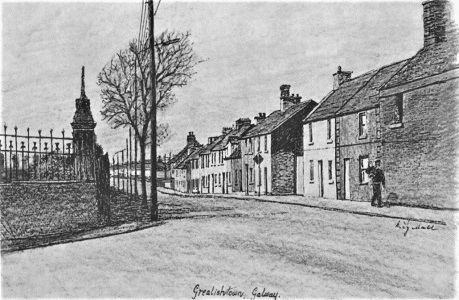GREALISHTOWN, A BRIEF HISTORY

by Tom Kenny
Grealishtown is the terrace of houses on the Bohermore Road opposite the New Cemetery. This was the main road into Galway from the east, An Bóthar Mór and it is probably as old as Galway itself. There were major fortifications in the area during Cromwellian times and there was a lot of military activity in the vicinity at the time. The new cemetery walls and chapels were completed by Thomas Nugent in 1880, and this part of the road was referred to as ‘Cemetery Hill’ for a time.
Some believe the area takes its name from a man called Grealish, who may well have built the houses. He was related to a Grealish family who owned a saddlery in Eyre Square where Fibber McGee’s is today. There were 17 houses, dating from the turn of the last century, mostly two stories, some single stories and they were stepped up the hill. The design was simple, when one entered the house, one stepped directly into the kitchen. There was a small bedroom and hallway off the kitchen. The stairs was near the front door and led up to two bedrooms. There were outside toilets at the back of the houses.
They also had a fine yard and garden and so most of the residents kept animals such as cows, pigs, chickens and hens. Because it was a terrace with no side entrances, these animals had to be brought through the houses. There were seventeen houses and a very close-knit community evolved there. The children of the area grew up like brothers and sisters. Their playground was the cemetery across the road where they played hide and seek among the headstones and the cocks of hay that were harvested in the open ground there every year. Timothy and Mary Walsh were the caretakers of the cemetery at the time and lived in the house just inside the gate. This was later occupied by Michael and Mary Geraghty and family.
Those who lived on the terrace, starting at Number 1 at the bottom of the hill were David and Bess Daly ; No. 2, Mike Gavin ; No.3, The Nolan Family ; No.4, Mr. & Mrs. Morrison. He was an officer in the British Army and saved his neighbour, Peter Casserly’s life twice ; No.5, Bridget Killilea converted the front of her house into a shop ; No.6, the Quigley Family ; No.7, Paddy & Bridget O’Neill ; No.8, Bartley and Mary Duggan ; No.9, Peter and Celia Casserly ; No.10, Martin & William Flaherty ; No.11, John & Bridget Corcoran ; No.12, Val Hehir ; No.13, The Geraghty Family ; No.14, Patrick & Mary Murphy ; No.15, Peter Concannon & Family ; No.16, Pat & Mary Scully ; No.17, Paddy & Nan Nan Kelly.
Our illustration today is a drawing of Grealishtown done by Michael Tyndall c.1990 that appears in the latest edition of St. Patrick’s Parish Magazine. This annual is full of local history and folklore and photographs and is great value at 5 euro. Our thanks to Margaret Long, Celia Fleming, Maureen Walsh and Mary McDonnell who compiled the original article in the magazine from which I have taken all of the above.
Finally, I thank all those who supported this column for the last year and those who passed on their comments, corrections, criticisms and witticisms. You make it all worthwhile. Blian Nua fé Shéan is fé Mhaise Díbh ar fad.
